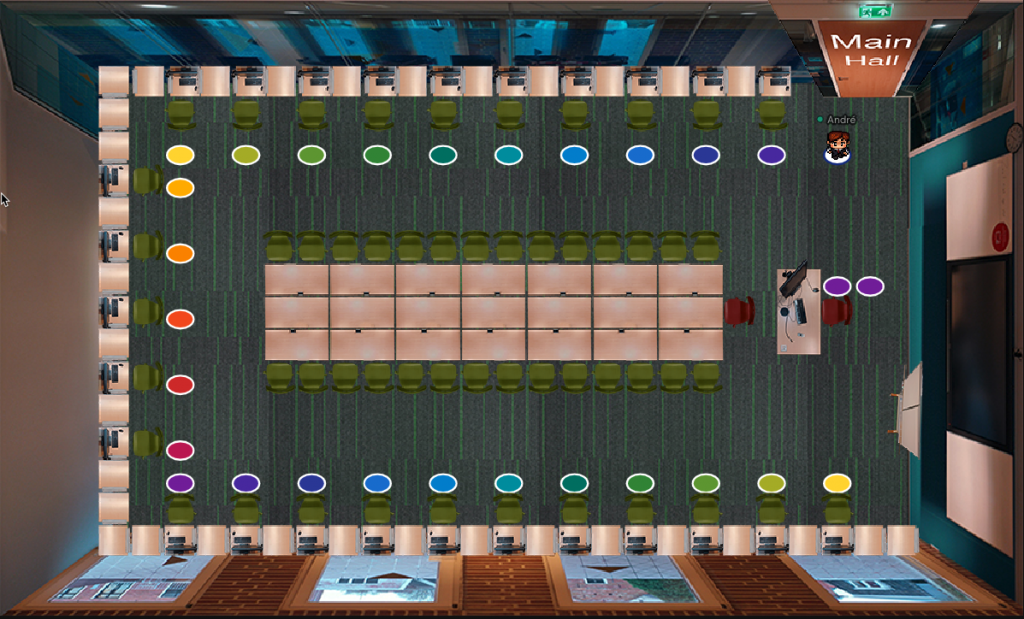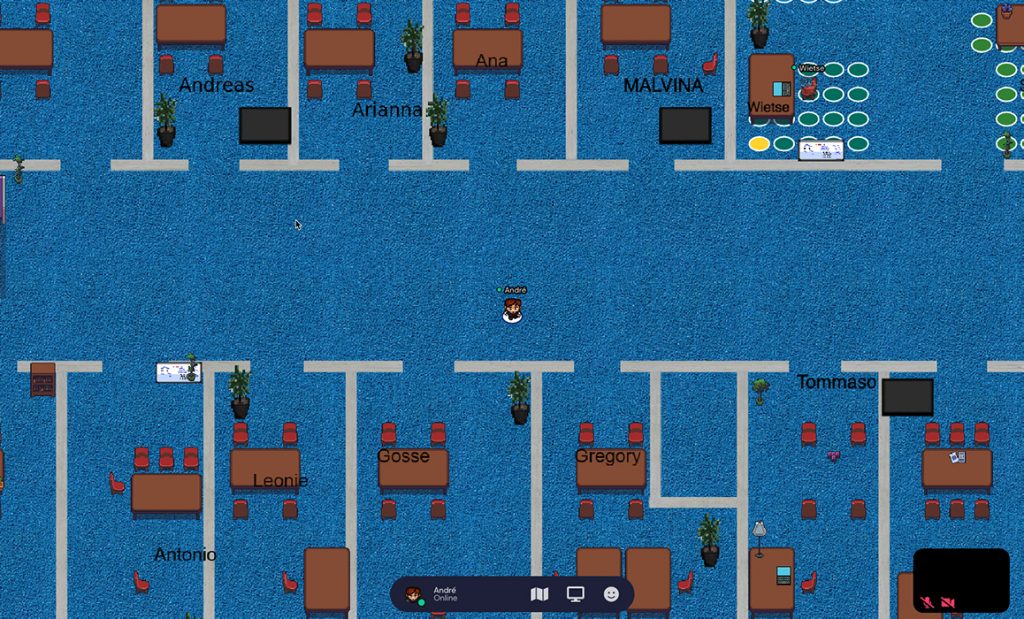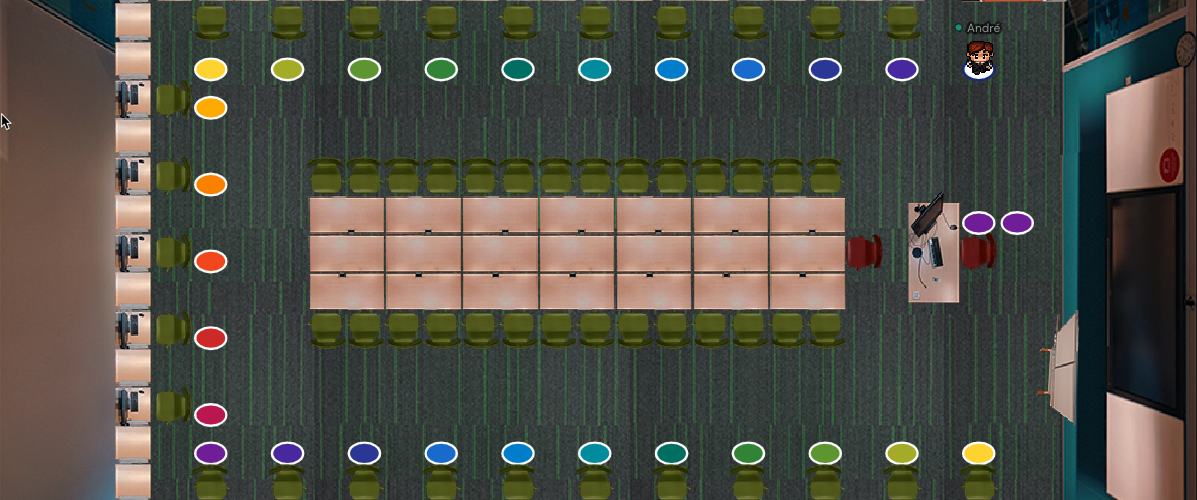Educational institutions, forced by COVID-19, have made the switch to online education. Students, teachers, managers and other employees spend a large part of the day looking at a screen with boxed camera images of others in the same position. This is tiring, static and not very interactive. Can immersive spaces offer a solution?
With admirable commitment from all involved, educational institutions have succeeded in converting their teaching into an online and/or hybrid format after the outbreak of the COVID-19 pandemic. This was not a conscious, deliberate or balanced transition: the term `Emergency Remote Teaching’ indicates exactly what it is: an emergency step. It is therefore not surprising that imperfections come to light. This happens, for example, in the synchronous video sessions, where ‘Zoom fatigue’ (see e.g. this article by Stanford University) is a new phenomenon. Instructors also struggle with activating students during these sessions and they, just as the students, miss personal contact.
One way of overcoming these limitations in traditional video lessons is to move away from the two-dimensional chequered matrix display of camera images and add a spatial dimension to the session. The participants move as avatars in a two- or three-dimensional space, have planned or accidental encounters there, and have at their disposal an arsenal of possibilities for carrying out tasks individually or together. Media and Learning organised a workshop on 29 April, 2021 entitled Exploring immersive meeting spaces for learning, where participants were introduced to three such platforms: Airmeet, FRAME and Gather. As the institution where I work, the University of Groningen in the Netherlands, is currently running a pilot exploring the possibilities of Gather, I will describe some applications using Gather as a reference. However, other platforms offer similar and sometimes additional possibilities.
Gather is a 2-dimensional environment where participants can move around in a space. This space can be based on one of the available templates, but can also be built from scratch. Each participant is visible via an avatar, but can in addition share his/her microphone, camera and screen, as in a normal video conferencing platform. In Figure 1, an existing teaching space (in this case, a computer lab) has been reconstructed. The chairs together with the coloured circles behind them are ‘private spaces’ – a student sits on one of the chairs and does individual work, while teaching assistants walk around the room. By standing on the circle behind a chair, the teaching assistant has a one-to-one conversation with the student in which the progress of the work is discussed. During this conversation, the student can also share his/her screen with the teaching assistant. Students can also walk up to the teacher, who sits on the right-hand side of the room. That too is a private space, which actually offers even more privacy than in a real lecture room. Finally, the chairs around the central tables also form a private space – this ‘circle’ arrangement is also present in the physical lecture room. When the teacher wants to address all those present, he/she moves to the ‘spotlight’ in front of the teacher’s table.

Figure 1: Computer classroom with private spaces. The room is a copy of the existing physical room, with windows displaying the environment of the building.
Interactive objects, such as a whiteboard, and external links can be placed in a Gather space. For example, Google Docs can be linked for collaborative work or instructions. Various spaces can be connected to each other (see for example the door to the Main Hall in Figure 1). In this specific central space, student groups can work together, teaching materials are available, and students can walk up to the lecturer in his/her private space. This is also possible after a lecture. The Main Hall itself is connected to a total of four computer labs, but also has a link to the course in the Learning Management System. Each space has capacity for up to 500 people, but by connecting multiple spaces, larger events are possible (during the Media and Learning webinar, a representative of Gather mentioned an event with 11,000 participants).
Gather is not only used for education. Below is a view of a part of our faculty building, where the office space of a number of staff members has been reconstructed. In this Gather space, colleagues can visit each other’s offices as they would in the real world. Other Gather spaces are set up for chatting after online webinars or for informal meetings between students and lecturers.

Figure 2: Part of a virtual office at the University of Groningen.
One of our lecturers recently conducted a survey about Gather among her students after her course. The majority of them thought that Gather was a successful addition to Blackboard Collaborate, our standard platform for online education. However, a third did not think so. The advantages mentioned were the sense of belonging to the group and the idea that the task at hand (working in a group on a poster presentation) had become more meaningful. Others saw no added value and experienced more technical problems than with Collaborate. Some also felt that the graphics were not academic enough (these students might feel more at home in, for example, the 3D environment of FRAME).
Immersive spaces are not new – in Second Life, for example, which started in 2003, there have been many experiments using it in education (e.g. Kawulich, B.B., D’Alba, A. Teaching qualitative research methods with Second Life, a 3-dimensional online virtual environment, 2018) . The applications described above are mainly emergency replacements for face-to-face teaching, and the need for them will decrease after the pandemic. Nevertheless, I do see opportunities for these platforms because part of education will take place online anyway. Think for example of Virtual Exchange, where students from different countries work on collaborative tasks. Online meetings and working from home will also continue to exist.
And unfortunately, the current pandemic will probably not be the last. It will be useful to know how and when to use immersive learning spaces.

Author
André Rosendaal is Project Manager e-Learning at CLIQ, the Center for Learning Innovation and Quality of the Faculty of Arts of the University of Groningen, The Netherlands













